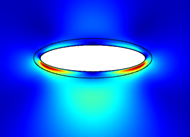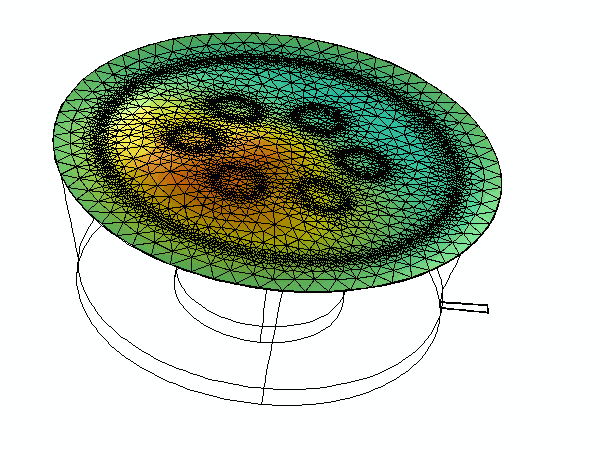
Last month, the Acoustical Society of America (ASA) and the Canadian Acoustical Association (CAA) held the 21st joint meeting of the International Congress on Acoustics (ICA) in Montreal, Canada. This joint congress is one of the major acoustics conferences of 2013, featuring a range of parallel sessions that covered most topics in acoustics. These included, among other things, psycho acoustics, underwater acoustics, transducer modeling, acoustics of musical instruments, nonlinear acoustics, and many more. This year’s acoustics conference also featured a poster session and plenary lectures. We were there, and here’s what we heard, saw, and said.
A Not-to-Miss Acoustics Conference
As the Technical Product Manger for the Acoustics Module here at COMSOL, this was an event that I simply could not miss. This particular acoustics conference is a good opportunity to get updated on the latest research in many areas of acoustics, but also to see what is being done simulation-wise in many areas. This year, for example, there was a special session on Computational Methods in Transducer Design, Modeling, Simulation, and Optimization.
As I walked around the conference, and listened to presentations in many different areas of acoustics, it was nice to see so many applications using COMSOL Multiphysics. A quick search of the conference proceedings reveals that COMSOL is mentioned in around 30 presentations. The areas of research where it is being used span acoustical oceanography, architectural acoustics, thermoacoustic phenomena, nonlinear acoustics, transducers, noise in hearing aids, the modeling of the speech production, and much more. All the abstracts of the conference can be found in the Journal of the Acoustical Society of America volume 133. Links to the conference proceedings will be available on the International Commission for Acoustics homepage.
I was fortunate enough to be invited and hold presentations in two of the sessions (one of which was the aforementioned simulation session). The first talk was about modeling acoustic radiation forces on microparticles — work I have done together with Prof. H. Bruus from The Physics Department at DTU. My second talk was about virtual prototyping of condenser microphones, and this work was done together with E. S. Olsen from Brüel & Kjær Sound and Vibration Measurement A/S. I will go into more detail on both presentations below.
Acoustic Radiation Force on Microparticles in Ultrasonic Standing Waves
My first talk was on “First-principle simulation of the acoustic radiation force on microparticles in ultrasonic standing waves” [1]; a continuation of the work I mentioned in the blog entry on microparticle acoustophoresis. The aim of the work was to make a model that could predict the acoustic radiation force on a microparticle, based on first-principle simulation. Theoretically, acoustic radiation is described by complex, non-linear governing equations sensitive to the detailed boundary conditions, making it hard to obtain quantitative predictions. Here, COMSOL Multiphysics is a very valuable tool as the user has full control over the solved equations as well as the solver sequence. The simulation results are compared to analytical results that exist for spherical particles in the adiabatic case. The current model extends the known analytical results to also include thermal effects, and it includes the analysis of the radiation force exerted on ellipsoidal particles (see figure below).

Streaming velocity amplitude
around an ellipsoid microparticle.
Virtual Prototype of a Condenser Microphone
The second work I presented at the acoustics conference was on “Virtual prototyping of condenser microphones using the finite element method for detailed electric, mechanic, and acoustic characterization” [2]. The aim of this paper was to present a full virtual prototype of a Brüel and Kjær type 4134 microphone that could reproduce all relevant characteristic curves, that is, the sensitivity for different vent configuration, the microphone impedance, and the microphone capacitance. All these were compared to actual measurements and showed very good agreement. The model of a microphone is a true multiphysics application that involves both acoustics, membranes models, and electrostatics. The model can be used to gain insight into the detailed physical processes governing the microphone behavior. In the future, it can be used to optimize existing microphones and help develop new prototypes. Below is an animation that shows the diaphragm displacement for an oblique incident acoustic wave at 25 kHz:

Movement of the microphone diaphragm in a BK type 4134 microphone for an oblique incident
plane wave (the motion is over one period and is highly exaggerated).
Further Reading
- Brüel and Kjaer 4134 Condenser Microphone model in the COMSOL Model Gallery
- Acoustofluidic Multiphysics Problem: Microparticle Acoustophoresis
- ICA-ASA Conference homepage
- Proceedings of the International Congress on Acoustics
- Acoustical Society of America
- Abstract reference 1: M. J. Herring Jensen and H. Bruus, “First-principle simulation of the acoustic radiation force on microparticles in ultrasonic standing waves (A)”, J. Acoust. Soc. Am. Volume 133, Issue 5, pp. 3236-3236 (2013)
- Abstract reference 2: M. J. Herring Jensen and E. S. Olsen, “Virtual prototyping of condenser microphones using the finite element method for detailed electric, mechanic, and acoustic characterization (A)”, J. Acoust. Soc. Am. Volume 133, Issue 5, pp. 3359-3359 (2013)




Comments (0)